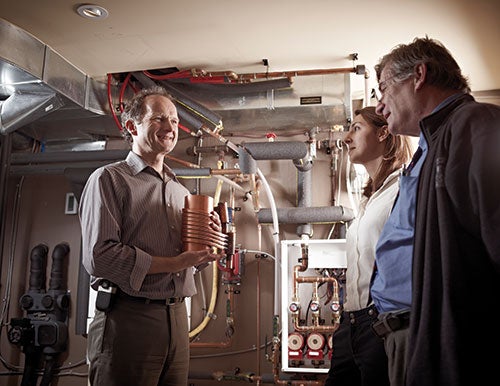
What consumes more energy - your smartphone or refrigerator?
Most people don’t realize how small devices consume huge amounts of energy, says Waterloo expert

Most people don’t realize how small devices consume huge amounts of energy, says Waterloo expert
By Sam Toman Faculty of EnvironmentThere are two great reasons to conserve energy: It saves money and the planet. But as Faculty of Environment researcher Paul Parker explains, some of the worst energy offenders are the small devices in our daily lives.

Geography professor Paul Parker left, Elena Krakjevska and Shane O’Neill explore energy efficiency at the REEP house in Kitchener.
Parker, whose research focuses on building sustainable communities by creating win-win opportunities for the environment and economy, gives us three small devices that are big energy consumers:
Cable box: You’ve just watched Game of Thrones, and it’s time for bed. You turn off the TV and hit power on your cable box. You’d think the power was actually off, but that little blinking red light means otherwise.
“As long as that light is on, the box is draining power,” says Parker. “On average, one of those boxes draws 15-19 watts continually. That adds up. Also, anything with a remote control is drawing power all the time. Good standby appliances only draw one watt, most draw far more. This is why connecting everything to one power bar you can shut off is a good idea.”
Smartphone: That little wonderful machine in your pocket actually causes as much energy consumption in a day as a standard refrigerator.
“It’s hard to believe, but true,” says Parker. “It’s not that your phone uses that much energy when you charge it each night. It’s the huge network of cell towers that keep you connected everywhere. When you open a browser, then hit search, servers in a distant cloud fire up to give you 100,000 answers in under a second. Those operations require massive amounts of energy to power and cool.”
Heat pumps: You may have never heard of them, but investing in a mini-split heat pump is a real energy saver in colder climates. Like standard air-source heat pumps, mini splits have two main components -- an outdoor compressor/condenser and indoor air-handling units. Mini splits are ideal for heating and cooling well-insulated houses with open floorplans. Many models can have as many as four indoor air-handling units for different rooms.
“People in Atlantic Canada have been using these for years,” says Parker. “I’m not sure why they haven’t caught on elsewhere. They are more efficient, customizable and have lower construction costs than conventional furnace and ducting. For every unit of electricity they use, they provide 3-5 extra units of heat compared to standard electrical heating systems.”
In good news on the electricity front, Parker points out that when coal-fired plants were a major source of Ontario power, charging an electric vehicle wasn’t a clear win for the planet. However, as Ontario and many other parts of the world move away from coal to natural gas and renewables, electric vehicles are cleaner than ever.
“Today, electricity is three times cleaner than it was before Ontario started to scale down its coal-fired power plants,” says Parker.

Read more
12 Waterloo students and postdoctoral fellows receive up to $10,000 in funding to develop their green-tech solutions

Read more
World-class researchers shape new ways to foster happiness and personal well-being

Read more
The Future Cities Institute founded by CAIVAN will bring together leading minds from across sectors to solve the most challenging and urgent issues facing global cities.
The University of Waterloo acknowledges that much of our work takes place on the traditional territory of the Neutral, Anishinaabeg and Haudenosaunee peoples. Our main campus is situated on the Haldimand Tract, the land granted to the Six Nations that includes six miles on each side of the Grand River. Our active work toward reconciliation takes place across our campuses through research, learning, teaching, and community building, and is co-ordinated within the Office of Indigenous Relations.